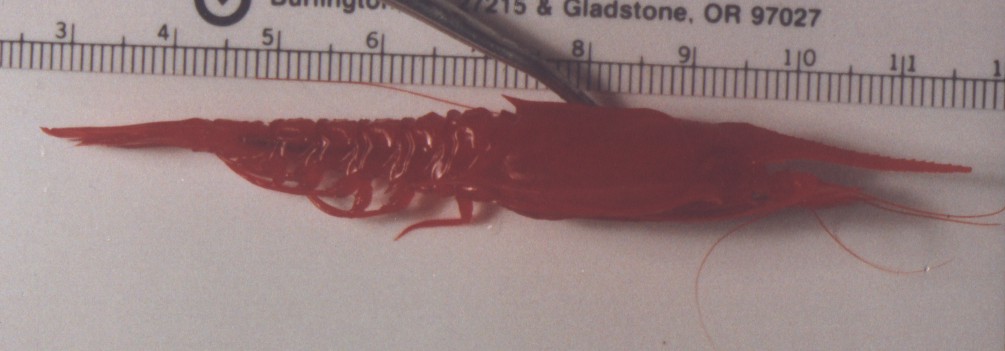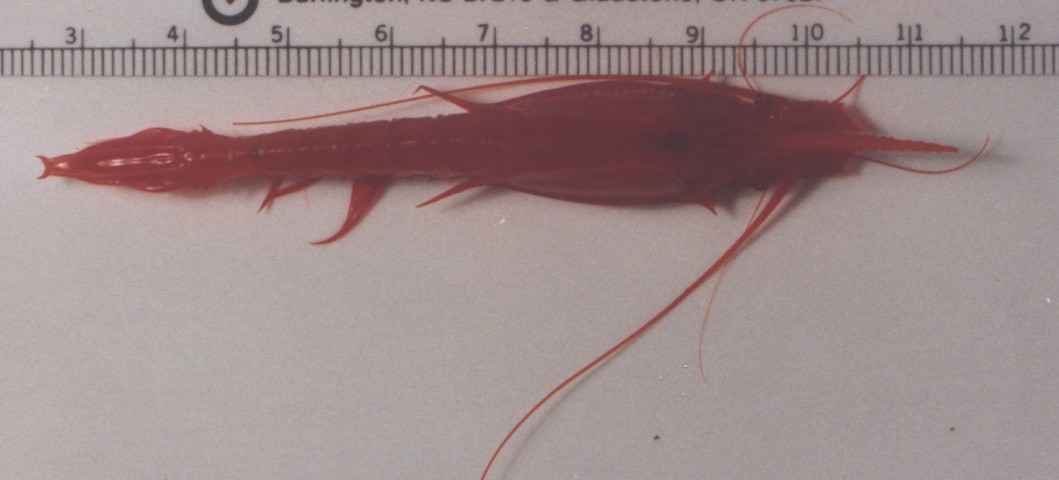Neognathophausia gigas (Willemoes-Suhm, 1875)Common name(s): |
|
| Synonyms: Gnathophausia drepanephora, Gnathophausia gigas |  |
| Phylum Arthropoda
Subphylum Crustacea Class Malacostraca Subclass Eumalacostraca Superorder Peracarida Order Lophogastrida Family Lophogastridae (or Gnathophausiidae) |
|
| Gnathophausia gigas from 700-800 m, San Clemente Basin, CA | |
| (Photo by: Dave Cowles, May 1996) | |
How to Distinguish from Similar Species:N. ingens has a relatively shorter rostrum with smaller serrations. Its antennal scale is ovate with small spines. Its supraorbital spine is small or may be absent. Both the anterior and the posterior lobes of the pleuralplates of abdominal segments 2-5 are pointed. Unlike Gnathophausia gracilis, this species does not have prominent dorsal spines on the abdominal segments.
Geographical Range: Cosmopolitan in tropical and temperate waters (to 60 degrees N and 69 deg S); from S Alaska south in our waters.
Depth Range: 600-4400 m
Habitat: Bathypelagic. Seems to live in waters of approximately 4 degrees C
Biology/Natural History: Reach sexual maturity at about 12 cm total length (including rostrum). Spination and relative length of rostrum is greater in smaller individuals, which originally led to small individuals being called the separate species G. drepanephora. This species is less common than is N. ingens off our coast (at least off California)
Lophogastrids were formerly thought to be a type of mysid. This species lives permanently below the euphotic zone. Neognathophausia gigas swims constantly, primarily with the pleopods, with some participation by the thoracic exopods (Cowles, personal observations).
Gnathophausia means "light-jaw". This species has a gland on its second maxillae (mouthparts) from which it spews a brilliantly luminescent cloud into the water when disturbed. Luminescence seems to be a function of diet, since animals of a related species, Neognathophausia ingens, maintained on non-luminescent food in the laboratory gradually lose their ability to luminesce, while if luminescent food is restored they can regain their luminescence (Frank et al., 1984).
Neognathophausia gigas is sometimes parasitized by an ellobiopsid flagellate protozoan, Amallocystis fascitus, which forms a cluster of white filaments on the ventral side of the anterior abdominal segment. The parasite seems to be associated with the main nerve ganglion in this segment, and is associated with hypertrophy of the ganglion. In N. ingens it also retards sexual maturation such as retarded development of oostegites in females and feminizing changes in males.
| Return to: | |||
| Main Page | Alphabetic Index | Systematic Index | Glossary |
References:
Dichotomous Keys:Kathman, R.D., W.C. Austin, J.C. Saltman, and J.D. Fulton, 1986. Identification manual to the Mysidacea and Euphausiacea of the Northeast Pacific. Canadian Special Publication of Fisheries and Aquatic Sciences 93. ISBN 0-660-12096-8
Pequegnat, L.H., 1965. The bathypelagic mysid Gnathophausia
(Crustacea) and its distribution in the eastern Pacific
Ocean. Pacific
Science 19: 399-422
General References:
Scientific Articles:
Ortmann A.E., 1906. Schizopod Crustaceans in the
United
States National Museum- the Families Lophogastridae and Eucopiidae.
Government
Printing Office, Washington DC
Pequegnat, Linda H., 1965. The bathypelagic mysid Gnathophausia
(Crustacea) and its distribution in the eastern Pacific
Ocean. Pacific
Science 19:4 399-421
Web sites:
General Notes and Observations: Locations, abundances, unusual behaviors:

The relatively long spines (compared with Neognathophausia
ingens) and the serrations on the rostrum can be
seen in this dorsal
view. Photo by Dave Cowles, May 1996
Notice the two spines forming a crescent shape at the tip of the
telson,
which is characteristic of Gnathophausia and Neognathophausia.
Authors and Editors of Page:
Dave Cowles (2006): Created original page